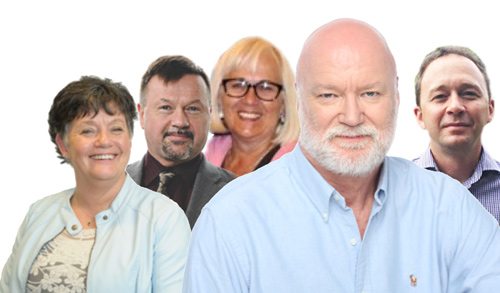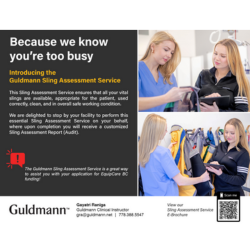
On Nov. 17, the BC Care Providers Association (BCCPA) and SafeCare BC hosted the first Care to Chat event of the season, titled Who Cares? Should More Be Done to Support the Mental Health & Wellness of Continuing Care Staff in BC?. The goal of this panel discussion was to start a conversation on mental health issues in the continuing care workplace.
The event was moderated by CKNW radio host John McComb. The expert panel featured Sandy Coughlin. Director of Occupational Health and Safety at Providence Health, Dr. Merv Gilbert, Principal at Psych Health and Safety, Jackie Spain, Operator of Golden Solutions and Simon Neill, Executive Director at Broadway Pentecostal Lodge. The panel discussed issues such as the prevalence of mental health issues in the continuing care sector, including what can be done both at an organizational and system-wide level to deal with such concerns.
The audience had an opportunity to participate in the discussion by posting questions on the interactive Pigeon Hole app. Although the panel got through many of the questions, there were still a large number that weren’t answered due to time restrictions. We reached out to a few of the panelists after the event and asked them to answer some of the questions that didn’t make it into the original discussion.
Sandy Coughlin
How can employers or managers evaluate whether they have created an effective culture of psychological health and safety in the workplace?
An effective culture of psychological health and safety is reflected in a number of ways, I believe. If employees feel safe and supported at work, they will miss less time, they won’t want to leave that employer and they will more quickly report any issues that come up. Managers should be able to identify and assist employees who are struggling at an early stage, rather than when it becomes such a problem that the employee has to leave work for an extended period. Employees won’t be afraid to report bullying and/or harassment issues, should they arise, although a safe and healthy workplace should result in a decrease of these types of problems.
What does a robust Psychological Health and Safety (PH&S) program at a care home or home care organization look like? What are the key, components including benefits of such a program?
I believe that a robust PH&S program has a clear reporting/investigation/follow up process, regardless of the issue. There needs to be demonstrated support of this initiative from all levels of management, but especially senior management – this has to be more than “lip service”, so not just a policy statement, but a clear demonstration that this program applies to everyone. It’s been interesting for me to hear from frontline staff that they don’t think our executive level struggles with many of the same issues they do. There has to be good communication about what challenges/barriers/solutions a care home or organization is facing. We strive to give staff regular updates on what we are focusing on and how we are using their input and feedback as we move through the process, but this can be a challenge because you aren’t always able to give staff what they want. I would suggest that managers review the 13 psychosocial risk factors identified in the National Standards for Psychological Safety in the Workplace and then have a look at what they already have in place – usually, many of the components already exist, but haven’t been identified formally. An organization could then determine what is important for them to work on short term, medium term and long term, by involving their staff from all levels. The benefits of doing this right would likely include reduced sick time, increased retention and a more satisfied staff who feel supported, which results in better resident/client/patient care.
Dr. Merv Gilbert
What does a robust Psychological Health and Safety (PH&S) program at a care home or home care organization look like? What are the key, components including benefits of such a program?
An effective psychological health and safety program is one that has clear commitment and involvement by management and staff with a shared understanding of why this is important. PH&S programs, policies and practices are based on a current assessment of needs within the particular workplace and include initiatives to support individual staff (e.g. self-care) as well as organizational initiatives (e.g. manager/supervisor training). These initiatives should be based on good evidence and practice and customized, as needed.
How can employers or managers evaluate whether they have created an effective culture of psychological health and safety in the workplace?
Successful and sustainable implementation of a PH&S system involves the creation of a Psychosocial safety climate, a feature of organizational culture that refers to “shared perceptions regarding policies, practices and procedures for the protection of worker psychological health and safety”. This is an incremental and ongoing process requiring ongoing review. Evaluation should include not only relevant lagging PH&S indicators (e.g. EFAP utilization, LTD rates due to psychological injuries) but also leading indicators (e.g. presenteeism, employee feedback). It is very important to be constantly evaluating employee awareness and trust of PH&S programs, policies and practices. The Psychological Health Awareness Survey for Employees (PHASE) was developed in the Standard evaluation project to achieve this.
Jackie Spain
Workload has been repeatedly tied to workplace stress and burnout. Can employers effectively address workplace mental health without first ensuring adequate staffing?
I think we have to do an analysis of staffing at our locations and decide if cutting staffing is actually saving money for the site. To do this analysis all aspects of the operation needs to be taken into consideration and looked at over a period of time. I would suspect that when that forensic audit is done we will find that we should look at staffing with a wider lens. Back in about 2000 when the Occupational Health and Safety agency was formed one of the first studies that was done and was proposed by HEU was to look at that and the consequences of increased workloads. At that time they were starting to get crushing and we were seeing increased injuries hence why OHSAH was formed. I believe that you cannot look at the one without studying the other. Workload is a large part of stress analysis and has been looked at in that aspect in a number of countries that have attempted to manage stress in workplaces.
Can you identify an innovative best practice or program that you believe should be expanded to improve the mental health and wellness of workers in continuing care?
I think the easiest thing for all to do to get ahead of this curve is to go the ‘Health Safety Executive’ website from the UK and download the information on the UK stress management standard and read. This is a very easy standard to read and understand. It could easily be looked at in sites and aspects could be instituted without much delay. Once you can understand that standard it is very easy to understand the Canadian standard and start down the road to a more healthy and productive workplace.





